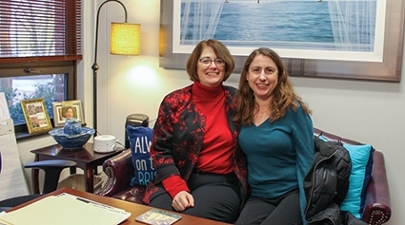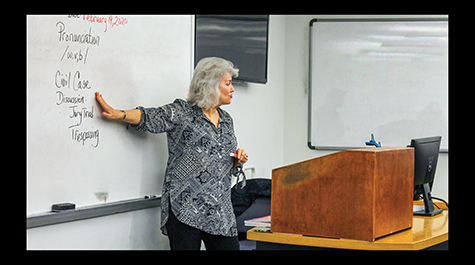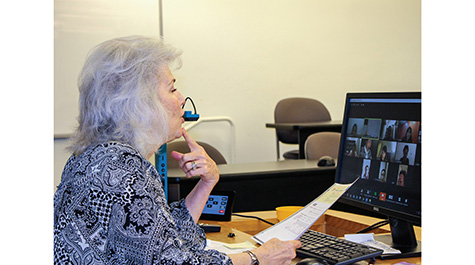William & Mary Law School's English Bridge Program: Using Technology as a Means to Educate, Engage and Recruit
It’s 7:25 am on a Friday morning in February at William & Mary Law School.
There isn’t a single student in classroom 133, but the professor, Carlene Klein, has already written on the white board the agenda for the day, and is readying her console, sitting so the video camera installed at the far end of the room can see her, and the microphone is placed correctly.
Precisely at 7:30 am — 8:30 pm in China — Klein takes a breath, flashes her captivating and welcoming smile and begins: “Good evening. I hope you are well.”
Gradually her monitor screen fills with her students’ faces, one at a time, as they log in. Klein speaks at a normal pace but with clear and careful enunciation. She exudes enthusiasm and warmth, but there is no wasted chit-chat; like her students, she is intent on making efficient and effective use of the next two hours.
Klein speaks at a normal pace but with clear and careful enunciation. She exudes enthusiasm and warmth, but there is no wasted chit-chat; like her students, she is intent on making efficient and effective use of the next two hours.
The assignment from the previous class had been to be able to describe in less than a minute what it looks like where they live. So Klein checks in with each student.
This spring the Law School’s English Bridge students are all from China, but located in various cities: Beijing, Tianjin, Weihei, Foshan and Guangdong. One student is currently in Malaga, Spain (where she was when the coronavirus broke out, so unable to return to China yet); and another is working in New York. The coronavirus is keeping the students in China in quarantine, so it may be that this class is the one thing in their lives that hasn’t been disrupted since the outbreak.
One by one they describe where they are. Rose lives in Tianjin. It’s cold outside. She describes the snow covering the trees. A student in Shanghai is confined to her house because of the virus, but remarks that she can tell it’s not as windy as it can be this time of year, which makes it nice. Frank is surrounded by bookshelves in his den — “I love to see your room with all those books!,” Klein exclaims. But no one can match Grace, who is in Malaga. She volunteers to turn her laptop around so everyone can see the view of the beach outside her window. Before too many facetious groans from the group, though, Klein brings things back on course.
“Remember, for this class, we’re in America. In Virginia. In an English-speaking class. OK? Let’s roll.”
Creative approach to finding and serving a new demographic
The English Bridge Program — an online and live-remote educational certificate program at William & Mary Law School — is the brainchild of Jennifer S. Stevenson, Associate Dean for Graduate Programs, Director, LL.M. Program & Professor of the Practice of Law; and Patricia E. Roberts, Vice Dean, Clinical Professor of Law, Director of Clinical Programs, and Co-Director of the Lewis B. Puller, Jr. Veterans Benefits Clinic.
The Program began with the fall 2019 session, and is now in its second (spring) session, which started January 31 and will end in May. The Veterans Benefits Clinic at the Law School has a certificate program with an online component and taped lessons, but the English Bridge Program is the first truly remote venture for the Law School.
William & Mary Law School’s Master of Laws Degree (LL.M.) program is designed for foreign-educated students and attorneys, and has successfully recruited and educated talented students from around the world for 30 years. Roberts and Stevenson, knowing that innovation is necessary to keep a program robust and growing, saw an opportunity to create a complementary program by expanding on existing capabilities, talents and resources at the Law School.
“We’ve had the Summer Legal Advantage program for many years, along with the freestanding summer program that we did for students who won’t necessarily come to the LL.M. program but want an experience in the U.S.,” Stevenson describes. “So we began looking for a way to reach candidates not in the LL.M. program, but who are either trying to get into the LL.M. program or just want to enrich themselves by doing this class,” Stevenson explains.
The English Bridge program is what has enabled them to reach a new demographic.
“They’re a different cohort than we’ve had before, because most of our LL.M. students are coming straight from undergraduate programs. The Bridge Program students are practicing lawyers, patent agents and legal assistants. Two are partners in law firms,” Stevenson continues. “So now we have a wider a range of experience and ages. They vary in age, but they’re all doing law.”
Designing a balanced and comprehensive curriculum
Armed with the idea for a new venture, Roberts and Stevenson collaborated with Klein to create the English Bridge’s 12-week program, consisting of 30 hours of Legal English and 30 hours of Global Lawyering Skills. Students are graded on their oral and written assignments and receive a certificate upon completion.
Klein brought her experience as an instructor in the Legal Advantage Program (Summer English Study for International Students & An Introduction to the Study of American Law), but she, Stevenson and Roberts needed to create something new, with different goals, parameters — and time zones.
“The Legal Advantage class is a second language learning environment (learning a nonnative language in the environment the language is spoken). The class is three hours per session which allows for more collaborative time as well as for covering more material,” Klein explains. “By contrast, the Bridge class is a foreign language learning environment (learning a language in the environment of one’s native tongue). Also, due to the time difference, it is only two hours per class which condenses the content.”
Legal English in the Bridge program focuses on basic language proficiency in the four language skills: speaking, listening, reading and writing. It integrates all four through functional, practical, and task-based lessons and activities that focus on correct pronunciation and getting accustomed to reading and discussing civil and criminal cases. Klein also schedules private 10–15 minute conferences to discuss students’ projects, pronunciation scores and subjects that focus on the individual’s progression. Klein notes, “I continue to brainstorm how to serve the Bridge class better within the time constraints. This semester, I am incorporating some prerecorded grammar lessons to allow more time in class for discussion.”
There is no language proficiency test for entrance into the program. Candidates self-report their language ability, but it’s difficult for language learners in any language to assess their conversational ability accurately. “They all have had numerous English classes in China, but in some cases, the Bridge students find it more difficult to acclimate to English based on how they have been taught in China – which is mostly focused on grammar rules and less on application,” Klein explains. “Many feel uncomfortable with the interactive application of English at first, so it takes more work to get them all to want to communicate in English. I try to encourage the students to imagine that they are in America so that we can treat it more like an immersion class.”
And this is where Klein’s expertise and sensitivity are clearly so key to the success of the program. “Building a rapport with the students in either class (live or online) is paramount,” says Klein. “Teaching English to other language speakers is a risk-taking activity for the students because most feel so vulnerable. Unlike lecture type courses, language learning courses force students to speak. Furthermore, they must endure criticism of their pronunciation or understanding of the language.”
Roberts has noticed that having the Bridge program has helped in improving the speaking ability of students in the LL.M. program. “Jen does a tremendous number of interviews for the LL.M. program, and if their English isn’t proficient enough, she can now suggest, ‘Why don’t you take English Bridge. So they get the 30 hours of proficiency training and are then are more likely than to succeed at William & Mary.”
Drawing on multiple experts
Besides the high-quality English language training, the students in the Bridge Program are also taught by talented professors from across the Law School who focus on a variety of different areas. This enables the students to have access not only to a wide range of expertise, but also to a variety of men and women with different teaching styles and speaking and writing styles.
Many of the Global Lawyering courses are taped. This spring’s courses are taught by:
- Jennifer Stevenson: Legal Writing Assessment
- Aaron Bruhl, Associate Dean for Research and Faculty Development and Rita Anne Rollins Professor of Law: Introduction to the U.S. Legal System
- Professor Thomas McSweeney: Introduction to Common Law
- Anna Chason, Professor of the Practice of Law, and Assistant Director, Legal Practice Program: Oral Reports
- Laura Killinger, Director, Legal Practice Program, and Clinical Associate Professor of Legal Writing: Introduction to Criminal Law
- Jennifer Franklin, Professor of the Practice of Law: Introduction to Advocacy
- Various W&M Law Faculty teach: Introduction to Legal Analysis; Client Counseling/Interviewing; U.S. Law Practice; and, Alternative Dispute Resolution (ADR).
Using existing technology in innovative ways
Another choice was to find a reliable, cost-effective method for real-time transmission. The Bridge Program uses existing technology at the university. Zoom, which is available to all William & Mary staff, faculty and students, is a cloud-based conferencing solution that provides both video and audio conferencing, mobile collaboration, screen sharing capabilities and online meetings. “I love Zoom because it allows for break-out rooms to do group discussions and partner work,” Klein says.
The program leaders are still considering the right balance between synchronous versus asynchronous teaching, and are careful not to use a method or tool that isn’t going to be effective and easy for the student and the teacher.
Classes are conducted in Williamsburg on Friday and Saturday mornings, and some Saturdays are videotaped lessons. “Interestingly when Jen and I were first designing this program, we thought we’d make it all live, but the students in China don’t want it to be all live. They want some of it taped,” explains Vice Dean Roberts. “They’re practicing attorneys, and they’d like to have access when it works for them. I also think that because of the language difference, it’s helpful for students to go back and replay the tape. So that’s been a change in this second iteration of the program.”
It makes for early mornings for Williamsburg teachers, but the fact that the students are working attorneys is key to the way they structure the schedule. “We do it on [what is their] Friday and Saturday nights precisely because they’re all practicing lawyers or doing something in the legal fields; they’re all working people,” says Stevenson.
Stevenson isn’t present at every class, but she pays close attention and finds when she does sit in, she is able to answer legal questions that may come up in the language discussions. “Jen is really intent on quality control and making this a high-quality program for William & Mary,” explains Roberts.
Face-to-Face in Beijing
The final weekend of the course was designed to be a live, interactive experience, so Stevenson and Roberts flew to Beijing in October and taught the fall cohort in person. “It was a great experience and really cool first, because it was my first trip to China, but we were also able to do some recruiting,” recalls Roberts. “We did the teaching, but we also interviewed some potential LL.M. candidates. Our spring cohort includes some of the candidates we met in Beijing.” Students worked together with Stevenson and Roberts for twelve hours over two days. The English Bridge group practiced client interviewing, negotiations, and other lawyering skills while immersing themselves in English language practice. After the weekend, a final legal writing assignment capped their months-long experience in U.S. law and global practice.
Roberts was astonished at the lengths to which the students went to get to the classes in Beijing, even knowing that the classes would be recorded for those who couldn’t make the trip. “I couldn’t believe how far some of them had come. Somebody spent nine hours on a train, and someone else took two airplanes. Their determination to take part was humbling.”
“This program is a tremendous commitment for them. You look at how many Friday and Saturday nights they’re giving up after working all week, and add to that the financial commitment, which isn’t small. And it’s hard work,” says Roberts.
While in China, Roberts met with the leadership of the Tianjin Bar Association to promote the Bridge Program. They have 10,000 members, and they sometimes supplement their members’ professional development. “It’s been tremendous that they have agreed to feature the program on their website and let their members know they will provide some tuition.” Stevenson and Roberts anticipate Tianjin will be a growth market. Even without the tuition support (because the agreement was finalized after the start of the session), about one third of the current class is from Tianjin.
And the “bridge” to the LL.M. also seems to be working. In fact, three students of the English Bridge Program are now enrolled in LL.M. this spring. One of them, Jason Guo, had majored in law as an undergraduate and worked for a year in a Chenggong law firm in Shandong province before participating in Bridge. He enrolled specifically to prepare to apply to the LL.M. Program. “I participated because I wanted to attend William & Mary.”
He is grateful not just for the improvement in his English language skills. “I’m used to the Chinese legal system, but the Bridge Program helped me understand the legal framework and concepts of the United States, which helped me adapt much more quickly to studying at an American law school.”
Greater enrollment in the Bridge Program will increase the workload, but Roberts is optimistic. “I do think it’s going to grow considerably, which means there will be more administrative work, but hopefully, there will be less work on implementation and curriculum design.”
Klein is very enthusiastic about the program. “I believe that the Bridge course was a brilliant idea for the Law School. Hopefully, this instills the self-confidence to come over to the U.S. and complete the LL.M. program, which in-turn affords them better job opportunities in their countries.”
Despite the coronavirus, Stevenson hopes to finish this English Bridge class in China. “The opportunity to have the course culminate in an in-person, executive training format is our goal. However, the live-remote technology gives us the flexibility to reach across oceans, if necessary, and connect the oldest law school in America to the rest of the world.”
About William & Mary Law School
Thomas Jefferson founded William & Mary Law School in 1779 to train leaders for the new nation. Now in its third century, America’s oldest law school continues its historic mission of educating citizen lawyers who are prepared both to lead and to serve.

